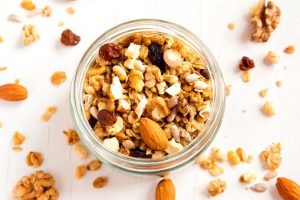
Lead author Bamini Gopinath said, “Our observations need to be confirmed by other large studies, and we can’t make recommendations at this stage such as pushing for a more plant-based diet. … there are numerous studies showing fiber’s protective influence against a host of chronic diseases.”
Successful aging was defined by the continued absence of physical disability, depression, breathing problems, or chronic health issues like high blood pressure or cancer. Gopinath added, “People can achieve the recommended intake of fiber consumption — around 30 grams per day — by eating a wide range of foods such as whole-grain breads and cereals, fruits, vegetables, and legumes.”
The researchers tracked the participants for a decade – the subjects were on average 49 years of age at the start of the study. By the end of the study, the researchers concluded that 15.5 percent successfully aged – those participants also consumed the highest amounts of fiber. Those who consumed the least amount of fiber were found to have worse aging outcomes.
Only 25 percent of participants were found to be taking in the recommended amount of fiber, which the researchers suggest is an accurate representation of the general public.
Top fiber foods include nuts, seeds, beans, avocados, strawberries, raspberries, blueberries, oranges, carrots, leafy greens, corn, peas, popcorn, bran cereals, and oatmeal.
The researchers at this stage can’t fully explain how or why fiber promotes disease-free aging, but they suggest it may have to do with a reduction in inflammation, along with the fact that fiber keeps people full reducing their risk of obesity, which is a risk factor for many chronic conditions.
Lona Sandon, an assistant professor of clinical nutrition at the University of Texas Southwestern Medical Center, added, “Different fibers also provide food for the bacteria in the gut. These bacteria may produce substances that help promote health such as hormones that help regulate appetite and blood sugar.”
The findings were published in the Journals of Gerontology.
Related Reading
High fiber foods for your daily diet
Fiber intake is an ongoing subject among many of us. We don’t eat enough, we eat too much, it constipates us and it makes us go. It’s hard to get the facts straight when it comes to fiber. The bottom line: fiber is essential, and knowing which foods provide high amounts of fiber can lead to overall good health. Continue reading…
High fiber may improve the lungs
A new study suggests that consuming a high-fiber diet may reduce the risk of lung disease. Study author Corrine Hanson said, “Lung disease is an important public health problem, so it’s important to identify modifiable risk factors for prevention. However, beyond smoking, very few preventative strategies have been identified. Increasing fiber intake may be a practical and effective way for people to have an impact on their risk of lung disease.” Continue reading…
Sources:
http://biomedgerontology.oxfordjournals.org/content/early/2016/05/23/gerona.glw091.abstract